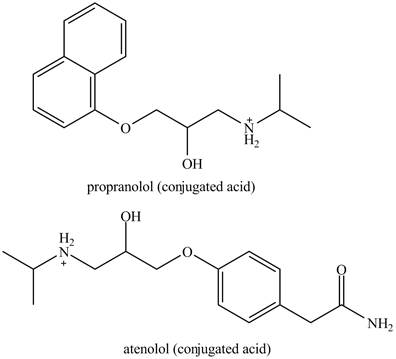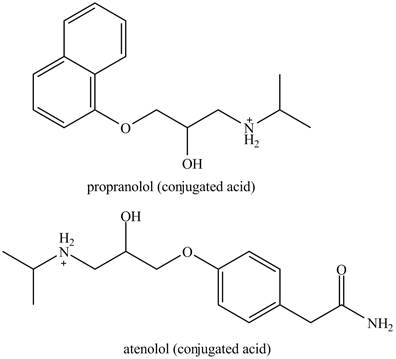
Concept explainers
(a)
Interpretation:
The drug which has greater partition coefficient is to be stated.
Concept introduction:
The partition coefficient is defined as the ratio of the concentration of the compound in two different solvents. The octanol-water partition coefficient is one of the most used partition coefficients which is the ratio concentration in octanol to the water.
Answer to Problem 8.54AP
The
Explanation of Solution
The structure of the two drugs is shown below.

Figure 1
From the structure of two drugs, it is clear that
Therefore, the partition coefficient of
The
(b)
Interpretation:
The concentration of atenolol in each phase is to be stated.
Concept introduction:
The partition coefficient is defined as the ratio of the concentration of the compound in two different solvents. The octanol-water partition coefficient is one of the most used partition coefficients which is the ratio concentration in octanol to the water.
Answer to Problem 8.54AP
The amount of atenolol is
Explanation of Solution
The given value of the logarithm of the partition coefficient is shown below.
Take antilog on both sides to find out value of
The formula of the partition coefficient is shown below.
Substitute the value of
The concentration of drug in octanol is
Since the volume of each phase is given same.
Therefore, the ratio of amount of atenolol in octanol to water is
Assume x to be the ratio constant to find out the amount in each solvent. Therefore, the amount of atenolol in water is x and in octanol is
The sum of both amounts is equal to the total amount.
Therefore the amount of atenolol is
The amount of atenolol is
(c)
Interpretation:
The relative water solubility’s of the crystalline atenolol and propranolol are to be stated.
Concept introduction:
The partition coefficient is defined as the ratio of the concentration of the compound in two different solvents. The octanol-water partition coefficient is one of the most used partition coefficients which is the ratio concentration in octanol to the water.
Answer to Problem 8.54AP
The
Explanation of Solution
From the structure of two drugs, it is clear that
Therefore, the partition coefficient of
That means
The
(d)
Interpretation:
The structure of the conjugated acids of the both drugs is to be drawn.
Concept introduction:
The drugs
Answer to Problem 8.54AP
The structure of the conjugated acids of the both drugs is shown below.

Explanation of Solution
The structure of conjugate acids of both drugs can be made by protonating the amino groups of each drug.
The structures of conjugate acids of each drug are shown below.

Figure 2
The structure of the conjugated acids of the both drugs is shown in Figure 2.
(e)
Interpretation:
An explanation about the change in the partition coefficient of each drug if it was determined again using water of
Concept introduction:
Answer to Problem 8.54AP
The value of partition coefficient for both the drugs will decrease on using water of
Explanation of Solution
The
This means the polarity of both the drugs will increase due to which their solubility in the water phase will increase. Therefore, the value of partition coefficient for both the drugs will decrease.
The value of partition coefficient for both the drugs will decrease because both the drugs will be present in the conjugated acids form and therefore their solubility in the water will increase.
(f)
Interpretation:
The reason as to why the drugs are formulated in the form of hydrogen chloride instead of using their basic form is to be stated.
Concept introduction:
Answer to Problem 8.54AP
The drugs are generally weak acids and bases and for dissolution or absorption in the body these forms are generally not ideal.
To boost their absorption and dissolution in the body, the drugs are formulated in the form of salts.
Explanation of Solution
The drugs are usually weak acids and bases but these forms are usually not optimal for the dissolution or absorption in the body. Medicines need to be water soluble as well.
The drugs are formulated in the form of the salts in order to increase their absorption and dissolution in the body. The salt forms are more optimal for the dissolution and boost its absorption in the stream of blood.
The drugs used in the form of salts in order to enhance its activity and dissolution in the body.
Want to see more full solutions like this?
Chapter 8 Solutions
ORGANIC CHEMISTRY SAPLING ACCESS + ETEX
- Understanding the general acid-base properties of amino acids O Proteins Imagine each of the molecules shown below was found in an aqueous solution. Can you tell whether the solution is acidic, basic, or neutral? molecule The solution is... 010 H3N-CH-C-OH CH HO CH3 O acidic O basic neutral O (unknown) H3N HO 0 O acidic O basic neutral ○ (unknown) H3N-CH-C-O CH2 CH3-CH-CH3 O acidic O basic Oneutral ○ (unknown) O= X H2N-CH-C-O CH3 CH CH3 acidic O basic O neutral ○ (unknown) ? 000arrow_forwardImagine each of the molecules shown below was found in an aqueous solution. Can you tell whether the solution is acidic, basic, or neutral? molecule 0=0 H3N-CH-C-o HO CH2 OH The solution is... O acidic O basic O neutral O (unknown) H₂N acidic O basic O neutral ○ (unknown) + H3N O OH O acidic O basic O neutral O (unknown) H2N-CH-C-O CH3 O acidic O basic neutral ○ (unknown) X ? olo HEarrow_forwardRecognizing ampli Draw an a amino acid with a methyl (-CH3) side chain. Explanation Check Click and drag to start drawing a structure. X Carrow_forward
- Write the systematic name of each organic molecule: structure name × HO OH ☐ OH CI CI O CI OH OHarrow_forwardく Check the box under each a amino acid. If there are no a amino acids at all, check the "none of them" box under the table. Note for advanced students: don't assume every amino acid shown must be found in nature. COO H3N-C-H CH2 HO CH3 NH3 O CH3-CH CH2 OH Onone of them Explanation Check + H3N O 0. O OH + NH3 CH2 CH3-CH H2N C-COOH H O HIC + C=O H3N-C-O CH3- - CH CH2 OH Х 2025 McGraw Hill LLC. All Rights Reserved. Terms of Use | Privacy Center Accesarrow_forwardWrite the systematic name of each organic molecule: structure HO-C-CH2-CH3 O -OH CH3-CH2-CH2-CH2-CH2-C-OH CH3 CH3-CH-CH2-C-OH Explanation Check S namearrow_forward
- theres 2 productsarrow_forwardDraw the major product of this solvolysis reaction. Ignore any inorganic byproducts. + CH3CH2OH Drawing Q Atoms, Bonds and Rings OCH2CH3 || OEt Charges OH 00-> | Undo Reset | Br Remove Done Drag To Pan +arrow_forwardDraw the major product of this SN1 reaction. Ignore any inorganic byproducts. CH3CO2Na CH3CO2H Drawing + Br Q Atoms, Bonds and Rings OAC Charges OH ОАс Na ဂ Br Undo Reset Remove Done Drag To Pan +arrow_forward
- Organic Functional Groups entifying positions labeled with Greek letters in acids and derivatives 1/5 ssible, replace an H atom on the a carbon of the molecule in the drawing area with a ce an H atom on the ẞ carbon with a hydroxyl group substituent. ne of the substituents can't be added for any reason, just don't add it. If neither substi er the drawing area. O H OH Oneither substituent can be added. Check D 1 Accessibility ado na witharrow_forwardDifferentiate between electrophilic and nucleophilic groups. Give examples.arrow_forwardAn aldehyde/ketone plus an alcohol gives a hemiacetal, and an excess of alcohol gives an acetal. The reaction is an equilibrium; in aldehydes, it's shifted to the right and in ketones, to the left. Explain.arrow_forward
 Organic ChemistryChemistryISBN:9781305580350Author:William H. Brown, Brent L. Iverson, Eric Anslyn, Christopher S. FootePublisher:Cengage Learning
Organic ChemistryChemistryISBN:9781305580350Author:William H. Brown, Brent L. Iverson, Eric Anslyn, Christopher S. FootePublisher:Cengage Learning
